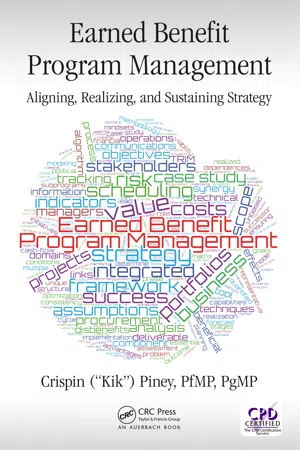![]()
Contents
Dedication
Preface
P.1 What Started It All
P.2 Some of the Original Ideas
P.2.1 A Consistent and Integrated Model
P.2.2 Typical Problem and Analysis
P.2.3 Integrating the Frameworks
P.2.4 An Honest Cost and Benefit Model for Programs
P.2.5 Calculating the Model
P.2.6 Disbenefits and Essential Links
P.2.7 A Case Study
P.2.8 Scheduling
P.2.9 Risk Management
P.2.10 Capacity Planning
P.2.11 Procurement
P.2.12 Implementation Tracking
P.2.13 Progress Tracking and Review
P.2.14 Stakeholder Relationship Management
P.2.15 Communications
P.3 References
Acknowledgments
About the Author
Chapter 1 Defining the domains
1.1 In the beginning…
1.2 Projects, programs, and portfolios
1.2.1 Why does this matter?
1.3 Projects and operations
1.4 Understanding the roles
1.4.1 Investor focus
1.4.2 Business focus
1.4.3 Supplier focus
1.4.4 Implementer focus
1.4.5 Review
1.5 Commonalities
1.6 Differences
1.6.1 Tools
1.6.2 Control
1.6.3 Easing the transition
1.7 Compromise terminology
1.8 Desired result
1.9 Conclusion on Ps, O, and T
1.10 Loose ends
1.10.1 Evolutionary projects
1.10.2 Integration projects
1.11 Towards total program management
1.12 Summary
1.13 Now to focus on programs
1.14 References
Chapter 2 Understanding the Problem
2.1 Overview
2.2 Synergy
2.2.1 The Need for Synergy
2.2.2 The Problem with Synergy
2.2.3 Characteristics of the Benefits Realization Map
2.3 Business and Benefits Management: The Core Concepts
2.3.1 Levels of Detail
2.3.2 Mindset
2.3.3 Time
2.3.4 Visibility
2.3.6 Accountability
2.3.6 Authority
2.3.7 Scope of Control
2.3.8 Impact
2.4 Structure of the Benefits Realization Map
2.5 Recap on the Benefits Realization Mapping Technique
2.6 Summary
2.7 The Need for End-to-End Control
2.8 References
Chapter 3 A Life Cycle for Program Management, Benefits Management, and Business Analysis
3.1 Introduction
3.2 Current life cycles
3.2.1 The program management phases
3.2.2 Program definition
3.2.3 Delivery of program benefits
3.2.4 Program closure
3.2.5 Linking the program to the benefits
3.3 Modified benefits realization life cycle
3.3.1 Defining the modified life cycle
3.3.2 Overview of the benefits realization life cycle phases
3.4 Close-up on the benefits realization life cycle
3.4.1 Benefits assessment
3.4.2 Business case development
3.4.3 Benefits realization planning
3.4.4 Benefits realization
3.4.5 The completion phase
3.4.6 Business analysis skills and tools
3.5 Integrating business analysis and project management
3.5.1 Vive la différence
3.5.2 Core concepts
3.5.3 Effective link to program management
3.5.4 The business analysis life cycle
3.6 Working with the business analyst
3.7 Case study: QERTS merger
3.7.1 Benefits assessment
3.7.2 Business case development
3.8 Summary
3.9 References
Chapter 4 Building an Integrated Business Model
4.1 Business Case Development
4.2 Contributions and Allocations
4.3 Description of the Benefits Realization Map
4.3.1 Entities
4.3.2 From Right to Left
4.3.3 From Left to Right
4.3.4 Reviewing the Completed Map
4.4 The Business Transformation Example
4.4.1 From Right to Left: The Business View
4.4.2 From Left to Right: The Technical View
4.4.3 Linkages Showing Relationships
4.5 Estimating the Contribution Fractions
4.5.1 Analog Evaluation Approach
4.5.2 Quantifying the Fractions
4.6 Applying the Concepts to the QERTS Example
4.6.1 Business Consultancy Approach for Building the BRM
4.6.2 Start with the Business Targets
4.6.3 QERTS Strategic Outcomes
4.6.4 QERTS Business Outcomes
4.6.5 QERTS Business Capabilities
4.6.6 QERTS Technical Capabilities
4.6.7 QERTS Initiatives
4.6.8 Completing the Map
4.7 An Honest Business Case
4.8 Summary
4.9 The Next Steps
4.10 References
Chapter 5 Calculating the Model
5.1 Picturing the Contributions
5.1.1 Identifying the Contributions
5.1.2 Calculating the Contributions
5.1.3 Remote Contributions
5.2 Understanding Allocations
5.3 Selecting the Algorithm for Determining the Allocation Fractions
5.3.1 Agreeing on the Allocation Fractions by Consensus
5.3.2 Using Contribution Fractions to Calculate the Allocation Fractions
5.4 Using The Contribution Values To Calculate The Allocation Fractions
5.5 Using the Contribution Shares to Calculate the Allocation Fractions
5.6 Calculating the Allocations
5.7 Defining a Decision Criterion
5.8 Proof that the Fourth Option Satisfies the Criterion
5.9 Summary
Chapter 6 Disbenefits and essential links
6.1 Allowing for disbenefits
6.1.1 The contributions in the disbenefits example
6.1.2 The allocation fractions in the disbenefits example
6.1.3 The allocations in the disbenefits example
6.1.4 Discussion on the disbenefits example
6.1.5 Percentage disbenefits
6.1.6 Are we there yet?
6.2 Essential contributions
6.2.1 First option
6.2.2 Essential node and essential contribution
6.3 Applying the concept of essential links
6.3.1 Prioritizing initiatives
6.3.2 Developing the financial justification for an initiative
6.3.3 Performing a risk analysis of the network
6.3.4 Optimizing the benefits realization map
6.3.5 Discussion on contributions and essential nodes
6.4 Creating an essential network
6.4.1 Picturing the essential contributions
6.4.2 Calculating the contributions
6.4.3 Conclusion: the value of the concept of essential contributions
6.5 Structured approach for removing nodes
6.6 Recalculating the pruned network
6.6.1 What’s in the BEER?
6.6.2 Step 1: Clear the redundant data
6.6.3 Step 2: Recalculate the pruned network contribution shares and contributions
6.6.4 Step 3: Calculate the contribution fra...
